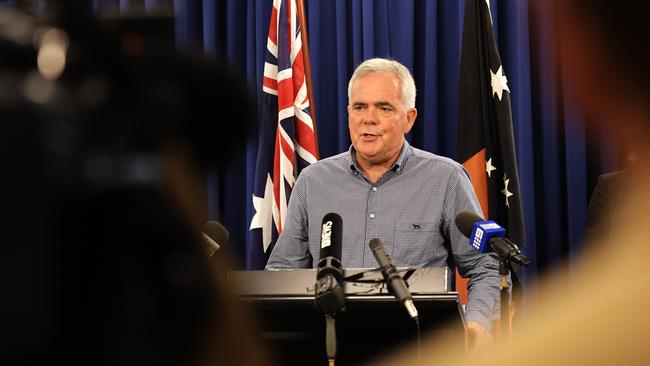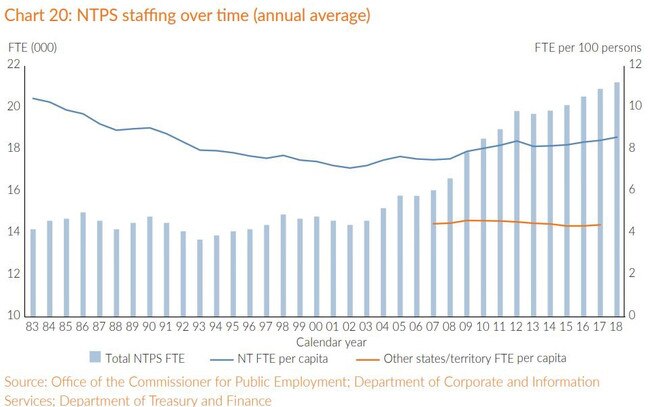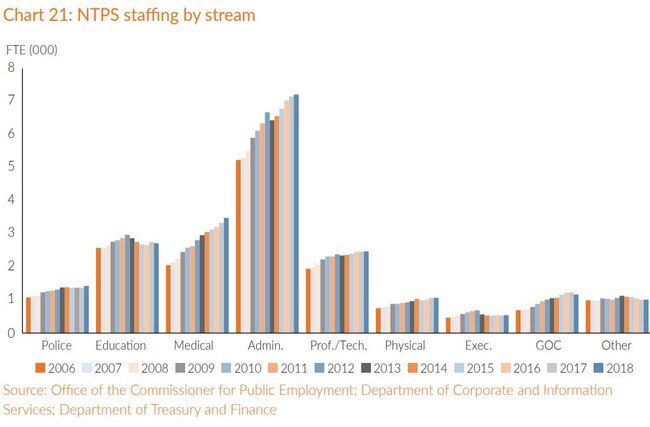No fixing financial mess without genuine public service reform
CUTTING the public service might end Michael Gunner’s political career but it’s the right thing to do for the NT, writes MATT CUNNINGHAM

Opinion
Don't miss out on the headlines from Opinion. Followed categories will be added to My News.
IF you want a simple summary of how the Northern Territory landed in its current financial mess, you’ll find it on page 92 of John Langoulant’s review into budget repair.
It’s a simple graph that charts the number of full-time public servants in the NT against the population.
For more than 20 years after self government the number of public servants remains relatively stable.
Then, around 2002, those numbers begin to rise, and — save for a brief period between 2012 and 2014 — continue to grow at an impressive rate.
NT forecast to return to surplus in a decade after Langoulant report released
UNIVERSITIES will be charged for NT health students placements
PUBLIC service executives could face sack for pay freeze refusal
From 1983 until 2002, the number of full-time equivalent public servants in the NT fluctuated between about 13,000 and 15,000.
Since then it has grown to more than 21,000, and despite promises of a hiring freeze, it continues to trend up.
Two key events have contributed to this growth.
The first was the introduction of the GST which delivered the NT a financial bounty it presumed would never run dry.
The second was the Intervention, with thousands of extra employees hired to address indigenous disadvantage, a task at which they appear to have failed miserably.

What’s most concerning about Langoulant’s analysis — and something that has been noted before by others — is that the sector where our public service has grown most dramatically has been in administration.
Medical staff have also increased, but police numbers have remained relatively stable and the number of people employed in the education department has been falling since 2012.
Former NT Council of Social Services president and chartered accountant Barry Hansen estimates about 40 per cent of the NT’s public service is now employed in an administrative or management role.
This compares to about 9 per cent in Western Australia.
Employee costs are the largest expenditure item in the NT budget, and whichever way you dice it, there will be no fixing our financial mess until we drag this elephant into the middle of the room and stare it right between the eyes.
Recent events, however, prove just how difficult this task will be.
The Gunner Government has bungled the handling of its pay freeze for senior public servants on executive contracts.
The Chief Minister at first claimed all of these executives would be taking the pay freeze before delivering an ultimatum this week that those who don’t sign up to the freeze will either get a bigger pay cut next time around, or no contract at all.
Mr Gunner has lost a bit of political skin over this issue, but it’s just a warm-up to the bigger battle he faces trying to rein in the wages of the rest of the NTPS, which are currently growing at a rate far higher than in the private sector.
Langoulant’s report recommends freezing annual pay rises at $1000 across the board.
The Government has accepted this recommendation, but enacting it in the lead up to next year’s election could be fraught with danger.
Two days before the 2012 election, Sky News’ political editor David Speers pinned down CLP Opposition Leader Terry Mills on his plans for the public service at a debate held at Pee Wees at the Point.
Mills confirmed he would consider cutting back the bloated public service, a move Labor immediately jumped on and one that certainly cost him votes in Darwin’s northern suburbs.
In a twist, it was a revolt in the bush from indigenous people who’d seen little improvement to their lives despite the growth in the NTPS, that saw Mills swept to victory.

As Langoulant notes, Mills — in his 2012 mini budget — made one of the few genuine attempts to address the growth of the NTPS, but it was a move that came at great political cost.
The public service remains the most powerful voting bloc in the Territory. Consider the numbers.
OUR best value NT News subscription deal yet: $1 a week for the first 12 weeks
There are just over 21,000 full-time equivalent public servants in the NT, but many NTPS employees work part-time, so the real number is far higher.
According to a report in The Australian last month, the actual number of NT public servants is almost 35,000.
That’s 35,000 people out of a total voting pool of about 106,000.
When you consider that most of those 35,000 public servants will also have spouses, or children or parents living here, you can safely assume more than 50 per cent of the electorate will be directly affected by any cuts to the NTPS.
COMPETITION: WIN a motorhome or caravan, plus other daily prizes up for grabs!
And if the recent federal election taught us anything, it’s that nothing trumps financial self-interest when it comes to swaying voters’ decisions at the ballot box.
For Michael Gunner, genuine reform of the public service could come at great political cost.
But for the Territory, as our debt grows and we struggle to adequately fund essential services, the cost of doing nothing will be far greater.


